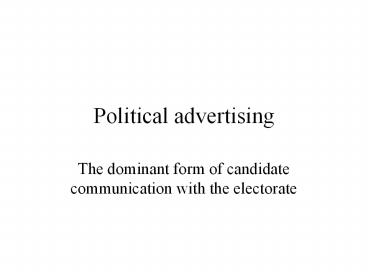Political advertising - PowerPoint PPT Presentation
Title:
Political advertising
Description:
Political advertising The dominant form of candidate communication with the electorate Female candidates Female candidates tend to focus more on issues than men do ... – PowerPoint PPT presentation
Number of Views:245
Avg rating:3.0/5.0
Title: Political advertising
1
Political advertising
- The dominant form of candidate communication with
the electorate
2
Political advertising
- Televised political advertising is now the
dominant form of communication between candidates
and voters in the presidential elections and in
most statewide contests - Kaid, Political advertising
3
Eisenhower Answers America
http//www.ciadvertising.org/student_account/fall_
00/adv382j/derrellwilson/p2/politics.html
4
Undecideds
- The swing vote in elections is made up largely
of those persons who are relatively ill-informed,
have a less-developed ideology and are swayed by
late events, advertising and non-policy news - They often decide the elections, though, and are
a major target of candidates - Going negative can work here
5
Content of political advertising
- Close analysis of the actual content of political
advertising has been rather limited - Relatively recent area of study
- Focused heavily on the presidential campaign
- Availability of historic advertising
- Most money, most sophisticated advertising
- Popular and scholarly focus on presidential
contest
6
Issues v. images
- Most advertising focuses on issues rather than
image - 78 of 2000 presidential campaign ads (historic
high) - However, the percentage of spots with specific
policy issue information was much lower than the
overall number of issue spots - Vague, general statements
- Claims without context (often misleading or even
false) - Researchers have come to conclude that the two
are intertwined and inseparable
7
Issues
Proportion of ads emphasizing issues Fear appeals
Bush 85 19
Kerry 79 5
8
2004 Issue Mentions (source Kaid)
9
Kaid The Television Advertising Battleground in
the 2004 Preseidential Election
10
2004 Candidate character mentions (source Kaid)
11
Negative v. positive
- There has been a significant increase in
negativity over the last 30 years
12
Positive v. Negative
- Challengers are more likely to engage in negative
advertising, while incumbents tend to be positive - Challenger criticizing record, incumbent
defending it - Attack ads are more common in competitive races
- Most races against incumbents are long shots
- Negative ads are more likely to be sponsored by
parties or advocacy groups - Negative ads have more substantive issue
information
13
Positive v. negative
- Positive ads tend to focus on the present or
future - Negative ads tend to focus on the past and
express anger
14
2000 all elections(Wisconsin Ad Project)
15
Overall appeals
16
Ad themes 2004 (source Kaid)
17
- http//pcl.stanford.edu/campaigns/2008/
- http//www.livingroomcandidate.org/
18
Attack ads 2004 (source Kaid)
Personally attack opponent Anonymous attack on opponent Attack on issues
Bush 0 95 92
Kerry 30 62 59
19
Goldstein, Lessons learned
20
(No Transcript)
21
Emotion
- Commonly seen by professionals as the most
important and effective appeal - People are not persuaded/moved by rational
appeals - Most political commercial use some form of
emotional appeal
22
Emotion
- The majority of political advertising relates in
some way to emotion - Tony Schwartz
- Frank Luntz
- What types of emotion are most often used?
- Fear
- Pride
- Especially national pride
- Hope
- Love
- Family
23
Appeals in presidential campaign advertising
24
Verbal content 2004
25
Emotion and cultural symbols
- Common use of non-rational appeals
- Clearly a successful strategy
- Spots contain an enormous amount of emotional
content - more emotional proof than logical or ethical
proof - According to Hart one must never underestimate
the importance of that which advertising most
reliably deliverspolitical emotion
26
Emotional appeals
- Winners use more words indicating activity and
optimism than losers. Losers, alternately,
demonstrated less certainty but higher realism in
their spots. - Ballotti Kaid, 2000
27
- http//pcl.stanford.edu/campaigns/2008/
- http//www.livingroomcandidate.org/
28
Incumbent strategies
Bush Kerry
Use of symbolic trappings 15 0
Presidency stands for legitimacy 12 0
Competency and the office 25 5
Charisma and the office 5 0
Emphasizing accomplishments 25 12
Above-the-trenches posture 7 0
Depending on surrogates to speak 5 8
29
Challenger strategies
Bush Kerry
Calling for changes 3 59
Speaking to traditional values 31 13
Taking the offensive position 19 16
Emphasizing optimism 31 28
Attacking the record of the opponent 61 54
30
Types of ads
- Diamond and Bates
- ID spots
- Argument spots
- Candidate causes, ideas, concerns
- Attack spots
- Visionary spots
31
Types of commercials
- Devlin
- Talking heads
- Negative spots
- Cinema verite
- Documentary spots
- Man-in-the street spots
- Testimonials
- Independent spots
- Joslyn Benevolent leader spots
32
Nonverbal content
33
Production techniques
Bush Kerry
Computer graphics 92 80
Slow motion 24 41
Fast motion 15 1
Freeze frames 14 14
Split screens 17 26
Superimpositions 20 13
Use of stills 7 30
Black and white changes 26 16
34
Female candidates
- Female candidates tend to focus more on issues
than men do, and to emphasize domestic issues - May be more due to greater number of Democrats
who are women than to gender
35
- http//www.rbistrategies.com/content/37/rbi-strate
gies-and-research-winspollierdquo-awards - http//pcl.stanford.edu/campaigns/2008/
- http//www.livingroomcandidate.org/
36
- http//www.pbs.org/newshour/vote2008/reportersblog
/campaign_ads/































